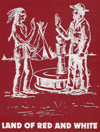 AN INTERVIEW WITH OSCAR VINGE
AN INTERVIEW WITH OSCAR VINGE
(JUNE 1968)
The Norway Valley school district was formed in 1919. At that time teachers were hired for about three months, because that was all the district could afford. After the time was up a teacher would move on to another school, possibly North Park or St. Margaret's. There was no government aid and previously taxes had run from about $2.25 - $5.00. With the school to support taxes went up to $10.00. Teachers' wages were sixty dollars and pupils were many. Nothing was supplied so Gus Brocke bought his own building for a teacherage. He was to remain in the district for some twenty years. Often payment to the schoolmaster, or mistress, was delayed.
The school house was built by Knut Rinde. Most of the lumber came from some thirty miles north of Frog Lake. Through a government debenture the building was put up and furniture purchased. From 1922 on there were no staffing problems. In a nine-month term the school might have three or four teachers. They boarded in neighborhood homes and this led to problems. Sometimes the teacher was not satisfied with the accommodation. In some cases hard feelings developed between families over where the teacher would stay. One time I drove to Kitscoty in my Model T to pick up the teacher. It was about midnight when we got back to Norway Valley. I took her to a home where she was supposed to stay. When the lady of the house opened the door and saw her she said to me, "Why don't you take her to Mrs. â's?" The girl began to cry and asked me to take her back to Kitscoty right then. Finally the lady agreed to let her stay.
When Norway Valley went into the St. Paul School Division the school was debt free and had $380 to the good. The community tried to purchase the building for a clubhouse. Another room was needed at Heinsburg, so in order to keep the building we would have had to pay $3 - 4,000 - what it would have cost to build on another room in town. After being moved in, and used for a time, it was sold to Eldred Lowe (U.G.G. agent), to be used as a fertilizer shed. The piano, which was purchased with money raised in the community, was also taken into Heinsburg. Teachers seemed to favor the move into the Division. There would be less direct negotiation with the ratepayers. The local school board had been able to fire a teacher and there was no avenue of appeal. As in other districts centralization had its advantages and its drawbacks. The school was the hub of the district and its loss seemed to do something to community spirit.


